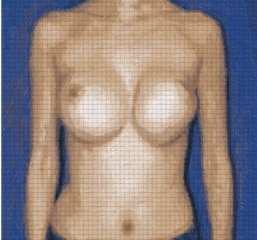implant revision
Despite undergoing a flawless breast augmentation by a reputable surgeon, certain complications may arise. Complications such as hematoma and infection occur after all types of surgery but certain ones are idiosyncratic of breast implant surgery. Specifically, “hardening” of the breast, which is also known as an encapsulation, may arise not too infrequently. When an implant is placed within the breast, it can be placed either above or below the pectoralis major muscle within a precisely defined pocket created by the surgeon. Amazingly, as soon as a week after surgery, one’s body forms a lining or a capsule around the margins of the pocket. This consists of collagen-type substance which in most cases adheres to the original dimensions of the created cavity. However, in a small percentage (approximately 6% of Dr. Haworth’s patients), this collagen-capsule shrinks inwardly, dramatically decreasing the size of the pocket accordingly. This inward contraction continues until the implant is tightly encased by the thickened capsule which results in a outwardly appearing shrunken, hard and distorted breast. In severe cases, there is associated pain. Rates of capsular contracture range from 25 to 40% when the implant is placed above the pectoralis major muscle while nationally reported averages for implants placed below the muscle are in the range of 12 to 15%.
The reason why Dr. Haworth’s are lower is because he not only places implants below the muscle (in a biplaner technique),but he also:
- Creates a vertically orientated “mega pocket”
- Creates an internal, simple natural drainage system to allow any blood accumulation within the pocket to dissipate harmlessly into the surrounding soft tissue. He rarely uses external drains.
- Encourages a strict postoperative breast implant displacement exercise regimen
- Utilizes a “No Touch” technique in handling the implant
- Employs a 360° sterilizing prep prior to placing the patient to sleep
- Utilizes many nuanced maneuvers and techniques to enhance the outcome.
Most encapsulations occur within the first 2 to 3 months after surgery. The first step in treatment is conservative consisting of aggressive breast implant manipulation exercises along with Accolate™, an asthma drug that happens to also help soften scar tissue in approximately 30% of cases. Failing this, a relatively simple 45-60 minute procedure called a capsulectomy may be performed. This consists of a total surgical removal of the capsule with a success rate of over 95%. This surgery is often times covered by insurance companies especially when the condition is associated with pain.

Another, more difficult problem that may arise from either primary breast augmentation or revision surgery is that of implant malposition. Most commonly, this may take the form of an implant that is situated too low in relationship to the overlying nipple-areolar complex imparting a “bottomed out” appearance associated with an inferiorly displaced inframammary crease. To correct these problems poses a real challenge to any selfrespecting surgeon and is generally referred to as a capsulloraphy. The inferior crease or fold of the breast needs to be securely elevated on the chest wall while retaining a graceful curve that is both natural and symmetrical with the other side. Permanent sutures are needed to accomplish this and accurately placing them can be very difficult indeed, especially through the small incisions that were originally used to put the implant in in the first place.

Another type of implant malposition is fortunately less common and occurs when the implants are positioned too close together. This situation is referred to as synmastia or “uni-boob”. Again, permanent sutures are needed to securely close the middle aspect of the pocket by suturing the overlying thin breast tissue to the breast bone. However, with aesthetic diligence and dedication, a good plastic surgeon can often accomplish the goal of re-creating beautifully natural breasts in the majority of cases.
Dr. Haworth sees many patients requesting revisions for distorted and hard encapsulated breasts. Some represent unfortunate results from otherwise well performed surgeries while others stem from poor surgical performance and judgment. Some require simple capsulectomies to perform, others may require more complex pocket modification –capsulloraphies (most commonly to elevate a dropped breast crease) while others require both. Dr. Haworth is an expert in this subspecialty of aesthetic plastic surgery.



